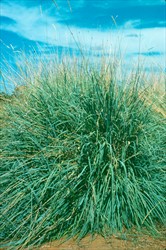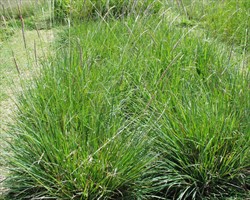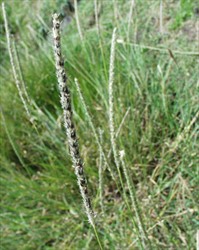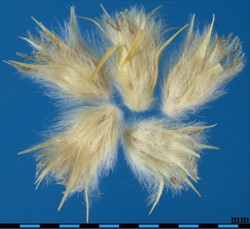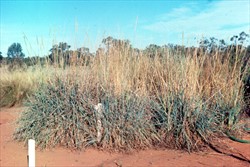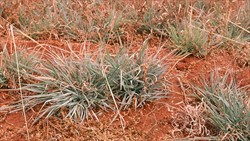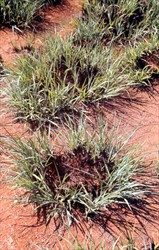Anthephora pubescens
Tropical Forages
Anthephora pubescens Nees
Anthephora hochstetteri Nees ex Hochst.
Family: Poaceae (alt. Gramineae) subfamily: Panicoideae tribe: Paniceae subtribe: Anthephorinae.
Perennial, tufted to densely tufted with unbranched culms 30‒100 (‒200) cm, short sturdy rhizomes, and long, narrow basal leaves forming a leafy tuft 30‒50 cm deep. Leaf blades green to blue-green, flat, linear, 10‒15 cm long and 3‒5 mm wide, tapering to a soft point; curling with drying, margins thickened, crinkled; ligule membranous, to 6 mm long. Inflorescence a straw coloured or dull purple false spike (cf. Cenchrus ciliaris), 5‒15 cm long, 0.5‒1 cm wide, comprising clusters (glomerule, fascicle) of 3‒11 spikelets surrounded by an involucre of stiff, narrowly elliptic bracts on reduced axis along a main axis; spikelets about 6‒11 mm long, densely pubescent, with lower glumes acuminate or shortly awned. Fascicle size varies considerably with ecotype, averaging about 125,000/kg, and caryopses 1,000,000/kg.
Africa: borseltjiegras (Afrikaans); otjimbele (Angola, Botswana); otjimbele, uruǀgâab (Namibia)
English: bottle brush grass, wool grass
German: ästiges Kruggras
Native:
Africa: Angola; Botswana; Eritrea; Ethiopia; Kenya; Mali; Mozambique; Namibia; Somalia; South Africa (Free State, Northern Cape, Gauteng, Limpopo, Mpumalanga, North West); Sudan; Uganda; Zimbabwe
Naturalized:
Western Asia: Iran
Cultivated:
Africa: South Africa
Forage
For warm season grazing, also providing useful standover feed (foggage) into the cool season. Sown in rows on sandy red soils in Republic of South Africa as a pasture/crop rotation. Makes high quality hay.
Environment
Revegetation of degraded lands; may have role in soil conservation in vulnerable sandy soils in semi-arid land.
Other
Can be used in rotation to reduce root knot nematode infestation.
A climax C4 species, found in semi-arid and arid grassland and savannah, often on hillsides.
Soil requirements
Common on sandy or gravelly soils, sometimes loams, with pH from 6.3 to 7.2. Not adapted to clay soils. In cultivation, recommended for sands and sandy loams with pH from about 5.8 to neutral. Grows on infertile soils and is more tolerant of low phosphorus levels than many other grasses.
Moisture
Occurs in areas with annual rainfall between 175 and 950 mm; most collections have been made from regions with between 350 and 500 mm. It is extremely drought tolerant, but intolerant of waterlogging and flooding. Normally recommended in areas with annual rainfall of between 250 and 650 mm.
Temperature
Extends from about 17º N in the Sudan and Eritrea to 29º S in South Africa, and to 2,100 m asl in Namibia. This equates to average annual temperatures from about 16‒28 ºC, with heavy frosts at the lower end of the range.
Light
No information available.
Reproductive development
Flowers from December to April in South Africa.
Defoliation
Grazing must be carefully managed, as A. pubescens is extremely palatable and can be grazed out. During severe grazing, tillers can be pulled from the ground. The tillers that are ripped out are at the periphery of the tussock because the central ones will have died/decomposed. While grazing should be very light in the first season, a carrying capacity of 1 LSU per 4‒5 ha (rainfall <400mm) and 1 LSU per 2‒3 ha (rainfall ±600 mm) can be achieved in subsequent seasons.
Fire
A. pubescens is tolerant of fire, with little adverse effect on regrowth and seed production.
Guidelines for establishment and management of sown forages.
Establishment
Seed may remain dormant for up to 9 months after harvest. As with other panicoid species, this can be broken down quickly by removing the glumes and planting the caryopses. "Seed" or fascicles can be broadcast at 5 kg/ha onto an at least partially cultivated surface, or sown in rows at 4 kg/ha. Seed should be placed on or near the soil surface, and compaction (rolling) during planting is vital. A. pubescens establishes readily.
Fertilizer
Although it normally grows on fairly infertile soils, A. pubescens may respond to applications of 20‒25 kg/ha P on very infertile soils, and to lime on more acid soils. Uptake of P is favoured by the presence of rhizosheaths on the roots. Moisture availability may limit response to applied N.
Compatibility (with other species)
Less competitive than Eragrostis curvula.
Companion species
Grasses: Normally planted as a pure sward since most other subtropical grasses are not adapted to dry, sandy soils.
Legumes: Chamaecrista rotundifolia, Stylosanthes guianensis var. intermedia, S. scabra at the higher end of the rainfall distribution.
Pests and diseases
No record.
Ability to spread
Although it has the potential to spread by adhering to the fur of animals, experience shows little inclination to natural spread. Rhizomes are short and sturdy and an ineffective colonisation mechanism. After 15 years, the crown may reach 50 cm diameter if gently grazed, and thereafter the edges fragment into a number of smaller sub-plants.
Weed potential
Not likely to become a weed in grazed lands due to its high palatability.
Nutritive value
Crude protein values range from about 7% in mature grass to 14% (with 62% IVDMD) at 50% flowering. P levels in the plant may vary from as low as 0.07 % in mature grass to 0.13‒0.20% in younger grass, depending on availability of P.
Palatability/acceptability
It is very palatable and is sought by domestic animals and wildlife.
Toxicity
None recorded.
Dry matter
Yields are mostly of the order of 3 t/ha DM under low rainfall conditions, and up to 9 t/ha DM under better conditions. While production is generally about 30% lower than that for Cenchrus ciliaris, the 90% greater utilisation rate compensates.
Animal production
No information available.
Apomictic. Chromosome base number for Anthephora, x = 9. Tetraploids, 2n = 4x = 36 and aneuploid, 2n = 20 observed.
Seed-heads are produced well above the leaves, facilitating ease of mechanical harvesting. Emergence of seed-heads continues for about a month, with a peak about 7 days after the first heads emerge. Seed ripens fairly evenly on each head. Ripe seed can usually be harvested 28‒32 days after emergence of the seed-head (i.e. 33‒39 days after first head emergence). With adequate water and fertilizer, two harvests per year are possible, once in early summer and once in autumn. Seed yields vary from 70 to 120 kg/ha, and up to 175 kg/ha for hand-harvested seed.
No information available.
- Extremely palatable, high utilisation.
- High quality feed (grazing, hay, foggage).
- Very drought tolerant.
- Very cold tolerant.
- Good seed production.
- Not fertility-demanding.
- Not adapted to clay soils.
- Does not tolerate flooding or waterlogging.
Moolman, A.C., van Rooyen, N. and van Rooyen, M.W. (1996) The effect of drought stress on the dry matter production, growth rate, and biomass allocation Anthephora pubescens Nees. South African Journal of Botany 62:41–45. doi.org/10.1016/S0254-6299(15)30576-7
Mynhardt, J.E., van Rooyen, M.W. and Theron, G.K. (1994) Competitive ability of two grass species: Anthephora pubescens and Eragrostis curvula. 1. Yield and biomass accumulation. South African Journal of Botany 60:261–268. doi.org/10.1016/S0254-6299(16)30601-9
O'Donnell, J.F., O'Farrell, R. and Hyde, K.W. (1973) Plant introduction and reseeding in the mulga zone. Tropical Grasslands 7:105–110. bit.ly/2Uug3Z4
SSW21A Selected in South Africa. Origin North West Province, South Africa (27º S, 24.7º E, 1,200 m asl, rainfall 450‒500 mm). More widely adapted, higher biomass production, better regrowth and quality than the "common" variety. Excellent heat tolerance. Selected by Agricol Seed.
CPI 43713 (Q 10665) Selected in S Queensland, Australia. Origin Lephepe, Botswana (23.3º S, 25.9º E, 1,040 m asl, rainfall 500 mm). Very good crown development and leaf production; 175 kg/ha seed production. Flowers December to April at 26.4º S. Mostly rated as "too palatable".
